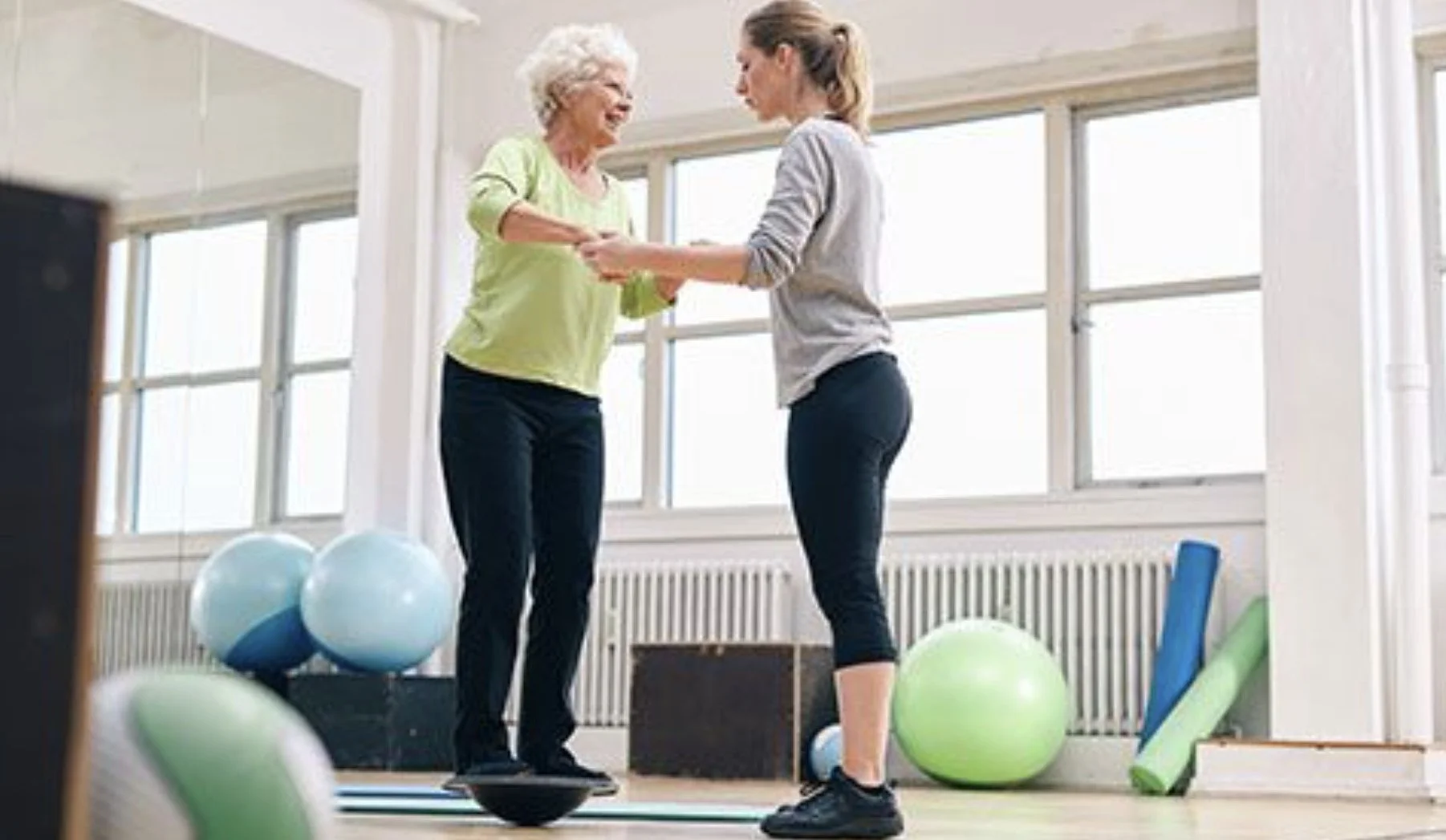
vestibular rehabilitation
If you feel dizzy or unsteady, we can help.
Vestibular rehabilitation
Do you get dizzy when you bend down to do the laundry, close your eyes in the shower, roll over in bed, do a quick shoulder check, or even just when you’re standing still?
If you’ve experienced this type of dizziness or vertigo, you could have a vestibular disorder.
Your first course of action should always be to see a doctor and make sure it’s not a sign of something more serious. After being checked by your doctor, vestibular rehabilitation treatment can help you find your balance and get back to life.
At Resolution Physiotherapy, our Vestibular Physiotherapists have completed advanced postgraduate training in vestibular disorders and rehabilitation and can help you on your journey to recovery.
What is the vestibular system?
Before you can understand your vestibular disorder and your treatment options, it’s helpful to start with breaking down what the vestibular system is and what it does when it’s functioning properly.
The vestibular system includes an apparatus of your inner ear, which helps you keep your balance and sense of where you are in space with all activities of daily life. Located deep inside the temporal bone of your skull, it is made up of semicircular canals, otolith organs and nerves that connect to parts of the brain. The various structures within the vestibular apparatus provide your brain with information about motion, equilibrium and spatial orientation. It also directs the reflexes going to your body, neck and eyes that help you maintain balance and clear vision while you’re moving.
What is vestibular dysfunction?
Vestibular dysfunction means that something has altered the vestibular system and caused it to stop working properly, which can literally throw you off balance.
Disease, aging, infection and trauma are among things that can lead to a vestibular disorder. Vestibular rehabilitation is recommended to manage and treat vestibular disorders and can help to improve and maintain your ability to participate in daily activities.
what are symptoms of vertigo?
Symptoms of vestibular disorders may include:
vertigo
dizziness
loss of balance
blurred vision
motion sensitivity
nausea
vomiting
headaches
vertigo vs. dizziness
Some people use these two terms interchangeably, but they’re actually not the same thing.
Vertigo is a sensation that you or your surroundings are moving or spinning when that’s not actually occurring.
Dizziness can refer to a range of symptoms, including lightheadedness, uneasiness, breathing too quickly (hyperventilating), disorientation, or feeling an exaggerated sense of motion when you move. None of these symptoms include feeling like you’re moving when you’re not, like what happens with vertigo.
Being able to accurately describe your symptoms (i.e. vertigo vs. dizziness vs. unsteadiness without any head symptoms) will help your doctor or other healthcare professional to properly assess your condition and recommend solutions.
Disorders treated with vestibular rehabilitation
Vestibular rehabilitation can be used to treat a range of vestibular disorders, including:
Benign paroxysmal positional vertigo (BPPV)
Unilateral (one-sided) vestibular hypofunction, i.e. damage left behind after things like inner ear infection (vestibular neuritis/neuronitis/labyrinthitis), trauma, Meniere’s disease.
Bilateral vestibular hypofunction – conditions affecting both inner ears
Central vestibular disorders – conditions affecting the brain structures involved in processing the information from our ears, i.e. vestibular migraine, head trauma, stroke, MS.
What is BPPV?
Benign paroxysmal positional vertigo (BPPV) is one of the most common causes of vertigo. It’s caused by the displacement of otoconia (small crystals of calcium carbonate), which travel from their proper place in the utricle of your inner ear into one or more of the semicircular canals. You experience vertigo when gravity makes the otoconia move in the canals with certain changes of head position.
What is labyrinthitis/vestibular neuritis?
These vestibular conditions are caused by viral or more rarely, bacterial infections of the inner ear or the vestibular nerve going from the ear to the brain. With labyrinthitis, individuals often experience a loss of hearing along with vertigo.
If you experience dizziness or vertigo symptoms, particularly if accompanied by sudden profound hearing loss, immediately visit your doctor or hospital. If the infection is bacterial, antibiotics will be used to treat it (as with colds or flus, you just have to wait until viral infections get better).
While you may get a full recovery after the infection goes away, some people experience lingering symptoms, which could suggest residual damage to the inner ear or nerve. This is when vestibular rehabilitation is required to help your brain adapt to the changes.
Vestibular rehabilitation therapy
Vestibular rehabilitation (VR), or vestibular rehabilitation therapy (VRT), is a form of therapy used to compensate, habituate or retrain the vestibular system and brain to reduce the symptoms of vestibular disorders, such as vertigo, dizziness, balance issues and gaze instability. Symptoms become less frequent and less intense. At Resolution Physiotherapy, our Vestibular Physiotherapists have completed advanced postgraduate training in vestibular disorders and rehabilitation.
Although damage to the vestibular system can be permanent, vestibular rehabilitation therapists can help you teach your brain how to use other senses (i.e. vision and body sense) to compensate for deficits. Research actually shows that the brain changes with rehabilitation.
Therapists will assess your vestibular system function and recommend specific treatments and exercises (in-clinic and at-home) as part of a customized rehabilitation plan.
Vertigo treatment
Treatment for vertigo depends on the cause. Common treatments include:
Vestibular rehabilitation: This therapy uses various tests and exercises and techniques to reduce dizziness and unsteadiness. Technology such as infrared cameras and blackout goggles for visual suppression may be used. Three types of exercises are often part of vestibular rehabilitation, including habituation, gaze stabilization and balance training. Your therapist may also give you at-home vestibular rehabilitation exercises to do, in order to continue your rehabilitation outside of sessions at the clinic.
Canalith repositioning maneuvers: These techniques are used to treat a common inner ear condition called benign paroxysmal positional vertigo or BPPV. The maneuvers move displaced crystals called otoconia from a part of the ear where they can create vertigo, back to where they belong. A commonly known repositioning maneuver is called the Epley maneuver, however your therapist needs to know several additional maneuvers to be able to correct all the possible locations of the displaced crystals.
Medication: Your doctor may prescribe medicine to relieve symptoms like nausea or motion sickness, as well as antibiotics or steroids if a bacterial infection or inflammation is causing your vertigo, however medications are typically only appropriate in the early stage. Longer-term use is thought to potentially interfere with recovery.
vestibular rehab barrie, vestibular treatment barrie
What are Infrared Goggles and how can they help me recover faster from Vestibular Dysfunction?
At Resolution, our Vestibular Physiotherapists are trained in the use of infrared goggles for vestibular rehabilitation. The use of infrared goggles in vestibular rehabilitation increases accuracy and efficiency when diagnosing vestibular disorders.
Infrared goggles allow us to visualize eye movements that would typically go unnoticed under normal room lighting. When you're in a well-lit room, your ability to focus your gaze (visual fixation) can minimize or suppress these movements. However, with infrared goggles, you are in darkness and unable to see anything, removing visual fixation. The infrared camera inside the goggles captures your eye movements, which are displayed on a computer screen while we perform specific vestibular testing.
Although it’s possible to assess and treat Benign Paroxysmal Positional Vertigo (BPPV) and other Vestibular Disorders without goggles, using infrared video oculography provides a clearer view of eye movements which is especially helpful for complex cases. Identifying the pattern of nystagmus is crucial in making accurate diagnoses of vestibular disorders, and allows us to pinpoint the affected ear and semicircular canal in BPPV. Infrared goggles also let us monitor eye movements during vestibular treatment maneuvers, ensuring they are performed correctly.
Additionally, the goggles record eye movements, allowing us to review and track change over time. These videos also provide you with a visual representation of what we observed, helping you better understand your condition and the treatment process.
If you are living with dizziness or other symptoms
of vestibular dysfunction, contact us today.
We can help.






